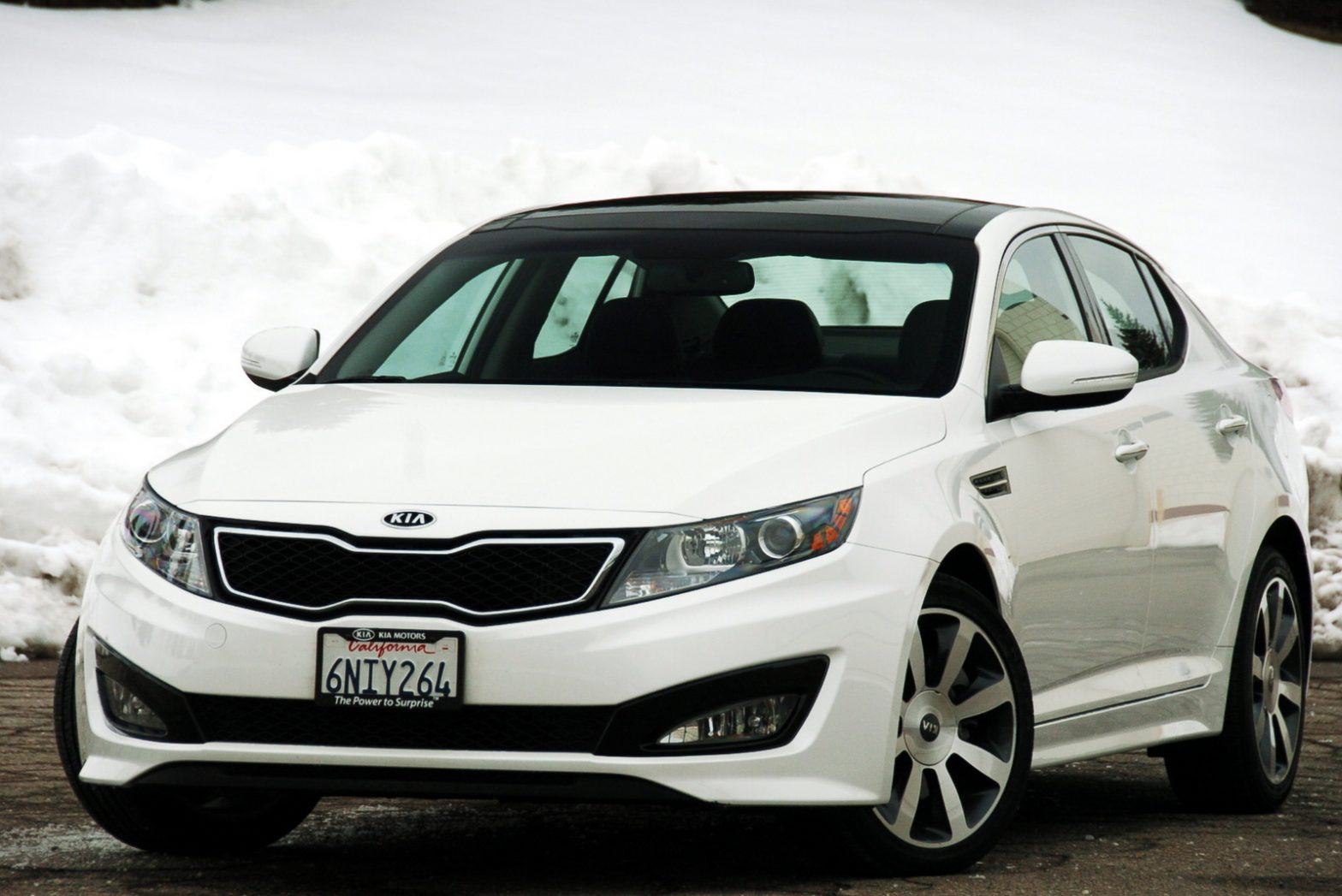In case you haven’t noticed, we really like what Kia (and sister company Hyundai) have been up to lately. Case in point is the new turbocharged Optima, which takes all the things that made the regular mid-sizer so great, and adds a big, fat helping of force-induction goodness.
First, a word about the looks. Like the standard car, the turbocharged Optima is a stunner, especially when coated in the Snow White Pearl paint of our tester. Combined with the blacked-out grilles (upper and lower), the subtle application of chrome, the stylized wheels, and the black roof, the Kia stood out in a way that few cars in the mid-size segment really can. (And looks like a good add to our eventual Cars Storm Troopers Should Drive list.) Inside, the cabin is pretty much the same as the Optima we tested back in January. The big difference is the black leather/white fabric seats that come with the SX Turbo trim. There isn’t really any extra bolstering, or indeed any performance impact at all, but they do look rather cool.
The Optima Turbo is motivated by a 2.0-liter, direct-injected and turbocharged four-pot (the same engine found in the Sonata Turbo) with 274 horsepower and 269 pound-feet of torque on tap. Notably, the torque peak comes on at an ultra-low 1750 rpm before falling off at 4500 rpm, meaning you’ve got a wide rev range to play with the oodles of turbocharged torque. Like the Sonata, the two things that generally wreak havoc on turbocharged front-drivers, torque steer and turbo lag, were very nicely controlled. Nailing the throttle from a standstill produced slight amounts of both, but counteracting them was a simple matter of adjusting our application of the gas pedal.
Like the Sonata, the Optima uses a six-speed automatic as the sole transmission choice. While we’d prefer a traditional six-speed manual, the autobox is a decent unit. Upshifts and downshifts are okay, but not particularly crisp. Switching to the manual mode and taking advantage of the steering-wheel-mounted shifters does deliver a more engaging experience, but doesn’t do much to sharpen things up.
When shown some turns, the Optima delivered a sure-footed performance that may only be bested in this class by the all-new Volkswagen Passat. There is a decent amount of feedback through the steering rack, but as always, more feel would be better. In terms of ride, the Kia is a bit rough around the edges, with harsher roads taking more of a toll on the suspension. On a smooth road though, it delivered excellent road-holding characteristics, and controlled body roll quite well. Lateral damping seemed to be its strong point, easily allowing controlled changes of direction without an overwhelming feeling of weight transfer.
We walked away from the Optima surprised at just how good this Korean mid-sizer has really become, as it now is able to stand toe-to-toe with the big guns of the mid-size segment. The power to surprise, indeed.
VS: Toyota Camry SE V-6
While they may bear a passing resemblance to each other, any similarities between the Camry and the Optima end with the visual. In terms of performance, the Optima has a slight six-horsepower advantage, but boasts an extra 21 pound-feet of torque, all the while hauling around almost 100 fewer pounds (3385 pounds in the Kia versus 3483 in the Camry).
There is an even greater disparity in terms of price and equipment. Our loaded Optima topped out at $30,840 while a comparable Camry will run you $32,115. Then keep in mind that said Toyota doesn’t have goodies like bi-xenon headlights, cooled front seats, or heated back seats, and the scale tips even more in favor of the Kia.
VS: Nissan Altima 3.5 SR
The Altima puts up a slightly better fight than the Camry, delivering 270 horsepower, but only 258 pound-feet of torque from its 3.5-liter V-6. The Altima is slightly lighter than the Optima (at 3357 pounds), but that weight advantage is relegated by a lofty torque peak of 4400 rpm.
Perhaps the bigger fault against the Altima is that the only available gearbox is a dreaded continuously variable unit. To be fair, Nissan’s CVT is better than most, but it still doesn’t deliver the involvement or driving pleasure of a traditional automatic. Factor in the $32,470 price for a fully loaded Altima compared to the $30,840 for our loaded Optima, and we can see again the value that the Kia provides.
2011 Kia Optima SX Turbo
Engine: Turbocharged inline-4, 2.0 liter, 16v
Output: 274 hp/269 lb-ft
0-60 MPH: 6.3 sec (est)
Weight: 3385 lb
Fuel Economy, City/Hwy: 22/34 mpg
Base Price: $25,995
As Tested: $30,840


